Designing silage clamps for year round feeding
One of the biggest privileges of an agricultural consultant’s career is being able to get an inside view of different farming businesses. In many ways these experiences are the most valuable part of the job, every day is a school day as they say and you can always learn something from a look at someone else's farm. More and more of the dairy farms I get to visit are housing their cows for all or most of their lactations. We are all aware that the system has its detractors, but the most successful dairy farmers I visit include a majority who house 365.
Diary cow housing by RE Buildings Ltd
How to feed cows housed 365?
So that begs the question, how do you design silage clamps for cows housed 365 days a year and is there any difference to a traditional winter fed clamp design?
Structurally, legally, and in terms of regulatory compliance, there isn’t any difference. But there is more to a good silage clamp than just those elements. A good silage clamp has to provide your livestock or digester tanks with good silage all year round. The size of the foundations or depth of the concrete floor slab haven’t got much to do with the quality of the silage the clamps provide.
So designing a silage clamp isn’t all about the structural capacity or regulations you have to follow. Before all of those things, you need to decide the size and shape you need to meet your requirements. As previously discussed, the “cheapest” solution isn’t usually the most cost effective. Of course we can measure cheapest in a number of ways. Many will just add up the costs on the invoices. A more accurate measure is to look at the cost per tonne of silage stored, but the ultimate “value” is to look at the cost per mega joule of energy fed…..
What’s the lowest cost silage clamp design?
Now that’s not a calculation anyone will ever make as it’s pretty complex but the message here is simple - think about the value of what the clamp is storing when designing the structure. This is because silage isn’t like grain, as you open up and start to use the silage, it starts to degrade and lose feed value. And feeding cows or digesters all year round speeds up this feed loss and sets a much more complex challenge.
This is because silage is spoiled when exposed to oxygen - well not actually by the oxygen - but by the microbes that thrive in an oxygen rich atmosphere. These guys turn your silage into heat, carbon dioxide and ethanol, none of which you can really see. Previously I have have looked at what we can do to minimise these losses and the number one, the golden rule, is to move through the open silage face at 2m per week (or a foot per day).
Silage clamp dividing walls
Now that 2m golden rule is going to get broken because it only holds in the relatively cool conditions of a traditional North West European winter. That’s because these microbes that turn silage into thin air are more active in warmer temperatures. So you need to move through the silage more quickly when it’s warmer. Obviously if you’re feeding clamp silage in the summer, you need to work through it much more quickly - probably at 3m per week.
So is that it, we just need to design longer thinner clamps?
Errrh - no not really, there are a heap of things that need to be considered. We will ignore the calving plans for the dairy herd because a) it’s too complicated and b) an ad plant manager won’t have any empathy with this problem. So let's assume we are trying to achieve a consistent diet throughout the year (and the AD manager really should be).
Firstly let's consider what you are feeding, the actual crops, and we will start with maize and whole crop silage because it’s much easier to plan with these. That’s because the maize and whole crops are harvested once a year - and generally the harvest is over a fairly short time frame. This just gets the crop into the clamps; this silage then needs to last or be fed out all year. If you assume half the year experiences cooler temperatures, then you need 26 weeks fed out at 2m per week and 26 weeks fed at 3m per week. By the power of simple maths, you’re going to need a clamp 130m long - or two clamps each 65m long?
That’s a simple solution to a more complex problem because I have some questions:
Will next years harvest be taken exactly 52 weeks after this years?
What do you feed whilst harvest is being carried out?
How long do you need to leave the crop in the clamp before you can begin to feed out silage?
With warmer autumns, do we really get 26 weeks of cool weather?
The usual solution once you include all these factors is to have at least one clamp that’s open at both ends so you can feed some old crop whilst the new crop is being harvested / fermented.
That makes siting and design the clamps a whole lot more complex but just wait until you start to think about grass silage. Grass silage will be taken in 2, or 3 or many more cuts. Its nutritional value will vary from cut to cut and predicting that value has become a whole lot more difficult since the effects of climate change have really begun to kick in. You will be using grass silage whilst the next cut is maturing and you or your nutritionalist might be changing the feed out plan as the summer proceeds. The first cut that you planned to feed in the New Year might have to be used this autumn because the weather/growing conditions have changed your perceptions of what you will have available and require. You know, farming happens….
So what do you do about this?
The best answer to this is probably get some coolheaded advice, but your design solution probably isn’t going to suit any other farm or situation. If you want a hard rule, keep yourself flexible - not with pilates (although that might help) but with wise, considered storage plans. Clamps that are open at both ends can really help. As can lots and lots of division walls.
Drivers hate them because filling and emptying narrow clamps is “more difficult”. But skilled drivers can work in narrow clamps and narrow clamps make good silage - or more accurately - good silage is fed out of narrow clamps. So start off by thinking about open ended clamps with movable dividing walls if you want to maintain a flexible approach to your clamp design.
Moveable silage clamp dividing walls
The ultimate solution might be a good floor slab with permanent walls on the two long sides and several sets of movable dividing walls to make clamps for each crop harvested as required. Or a mix and match of movable and fixed division walls - you need to have a good long think about it…..
All we need to do then is think about how to design the floor falls, and the wall heights and…
If you want to discuss designing clamps for year round feeding or world like to discuss any other topics covered in this series then please contact me at jeremy@silageconsultant.co.uk
If you have found this article interesting why don’t you subscribe?


